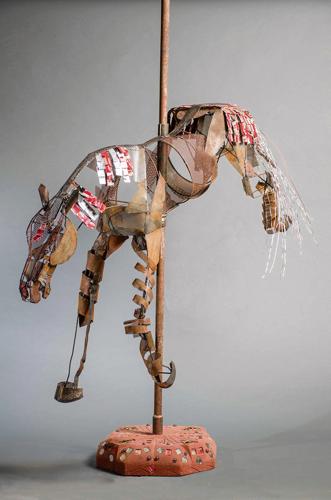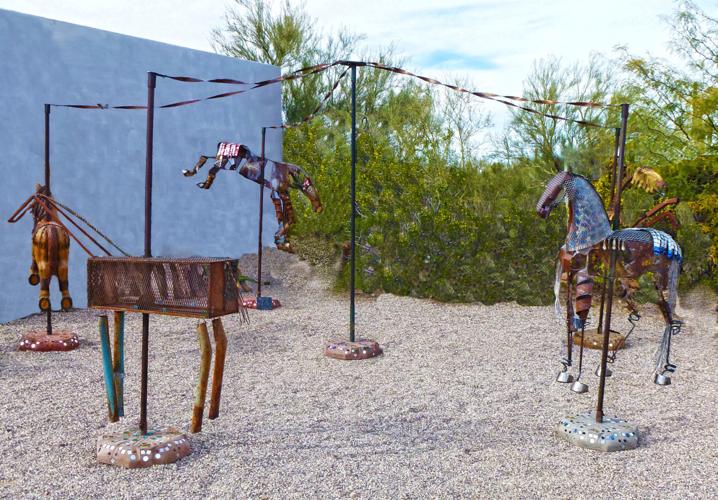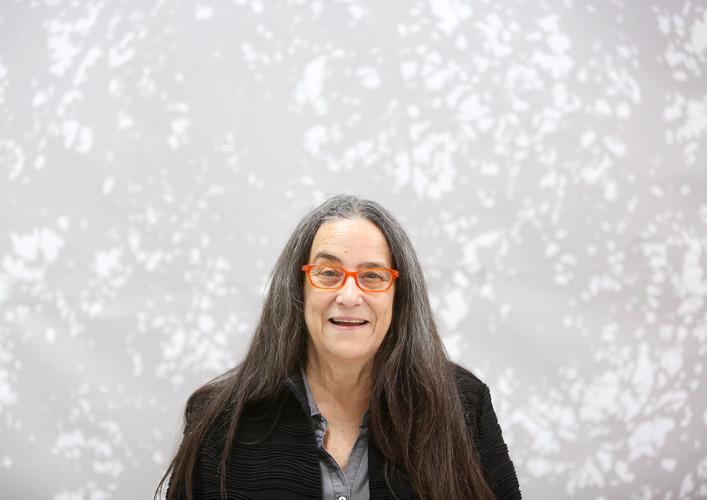“Oh, wow” is a frequent reaction when driving by the soaring “Sonoran Passage” sculpture over the Kino Parkway bridge, marveling at how it evokes the desert as the sun glints off the shiny aluminum.
The multipiece “Front Row Center” in front of the Marroney Theatre on the University of Arizona campus often elicits a slight giggle or big smile at the oversized, whimsical chairs, the tile benches and the canopy with an old Macintosh computer, a paintbrush and other implements essential to making art in its many forms.
A new arts group seeks to expand those gee-whiz moments and to make sculpture part of your everyday life.
“Besides public art, we want to bring energy and focus to the existence and importance of sculpture and that it enriches life,” says Barbara Grygutis, a founding board member of SculptureTucson.org.
To help meet that goal, the group is presenting the inaugural Sculpture Festival Show and Sale, Friday-Saturday, April 6-8 at Brandi Fenton Memorial Park, 3482 E. River Road.
“Sculpture has to be seen in person, to be experienced,” says exhibiting artist Lore Stephan, who is from eastern Pennsylvania and now has an atelier in a quaint village in “the foothills of the Alps” in Austria.
A two-dimensional photograph does not do justice to a piece of sculpture, Stephan says.
The show’s impetus was three years ago when Grygutis, the “Sonoran Passage” and “Front Row Center” artist who has more than 75 art pieces dotting the nation’s public spaces, teamed up with Steve Kimble, who designed and built Tucson’s Metal Arts Village, and Jeff Timan, a partner and the director of gardening and art of the Hacienda Del Sol Guest Ranch Resort.
The trio met weekly and the results are the new arts nonprofit, SculptureTucson.org, and this weekend’s curated show, both aimed at promoting sculpture as accessible art and ramping up awareness of all forms of sculpture, large and small, public and private, says Grygutis.
Sculpture does not get as much gallery space as other forms, and when seeking to purchase a piece of art for a home or office, sculpture is often not considered, says Grygutis.
Likewise, art shows often emphasize two-dimensional work and craft items, says Stephan.
“Sculptures are three-dimensional objects that transcend function,” says Grygutis. Sculpture can have function — like the chairs in “Front Row Center” — but functionality is not the basic purpose of sculpture.
Regardless of the medium — stone, clay, metal, paper, wood, found objects — the third dimension differentiates sculpture from other art forms, Grygutis says. Relief, in which elements are raised from a flat background, is sculpture, even though it might hang on or be part of a wall.
WHAT TO EXPECT
Festival-goers may be surprised at seeing “the quality of work in our community and see all types of sculpture together,” says Grygutis. About 40 artists will bring a full, complementary palette of traditional and modern methods, mediums and styles to the festival.
While there is a high percentage of artists from the Tucson area, artists come from all over the nation, and Stephan is from Austria. Each artist will have a booth for small pieces and there will be a large, open-air gallery for large pieces, Grygutis says.
“This event is a wonderful compilation of many different techniques of artwork and represented by top sculptors in Tucson,” says Pat Frederick, a retired veterinarian whose sculptural carousel will figuratively prance in the park’s horse arena.
“Carousel of Life” has five horses clip-clopping through different phases of life and aspiration, Frederick says.
Stephan will be bringing 14 papercast pieces, mostly featuring imagery of the divine feminine, to the festival.
Stephan has worked in various sculpture mediums, such as bronze and resins, and says casting marries her love of sculpture and painting, as the colors on the paper fibers pop with beauty and vibrance.
She sticks with simple, earth-friendly elements. Paper casts are a strong medium, yet they are lightweight and easy to ship, especially from Austria to the United States.
Stephan is also bringing a video of her work “Earth Justice,” an indoor, life-size piece in Pennsylvania.
“I’d love for lots of people to see the video and find patronage to create it in a durable media for outdoors,” Stephan says. “Seeing the sculpture inspires one to have hope and trust that we can restore the balance to our planet.”
HOT STUFF
Blacksmithing and glass blowing will be demonstrated at the festival, too.
Clint Nelson and his children, Alexander “Xander,” 14, Sophia, 11, and Sam, 8, will show blacksmithing skills Saturday.
Molding steel under their own hands gives his children an immense feeling of accomplishment and personal power to do such a creative, physical and dangerous activity in this computer generation, Nelson says.
The children “love their craft, and they are proactive in promoting it,” he says.
The Nelson family will not be showing their work at the festival. However, Ira Wiesenfeld, who will demonstrate on Sunday, will be exhibiting.
There will be art for your ears, too. Jeannie Walker/Patrick Kelly, the Red Clay Trio, the Ras Brothers and the George Howard Band will perform Saturday. And on Sunday, the Junior Strings, Bryan Dean, Gracie Jessop and the Falcons will take the stage.
Don’t worry about lunch; food trucks will be there.
GETTING THE PARTY STARTED
The festival kicks off Friday, April 6, with an evening reception during which Tucson Mayor Jonathan Rothschild will proclaim sculpture month.
Keynote speaker will be Tohono O’odham artist Terrol Dew Johnson, who is known for his experimental weaving and use of materials historically used by his tribe, especially gourds. The reception and preview is $50.
WHAT’S NEXT
Grygutis hopes the sculpture festival becomes a signature event for the community, along the lines of the Tucson Festival of Books.
“We need to help visual artists show in this way (in a public venue) because most of the efforts to make art occur in studios without observers,” says Frederick.
“I feel that concentration of artists in such a manner without the addition of established businesses surrounding the show is more conducive to thoughtful appreciation,” she says.
SculptureTucson.org is an all-volunteer effort, says Grygutis, who will not be showing at the festival — her work is too large. She, Kimble and Timan are the group’s board of directors; Steven Derks and Moira Geoffrion are on an advisory board; and Denise Grusin was the event organizer with coordination aid from Katie McCann, Robyn Kessler and Nanci Beizer-Fink.
Grygutis hopes the scope and impact of the festival and the group will expand, enabling the group to host more events and projects and hire a part-time administrator to help with the festival.
But for the immediate future — this weekend’s festival — Grygutis hopes community members will come to the festival to look at sculpture, buy sculpture and take sculpture home.
Grygutis’ festival goal: “No sculpture left behind.”









